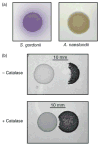Role of hydrogen peroxide in competition and cooperation between Streptococcus gordonii and Actinomyces naeslundii
- PMID: 18785881
- PMCID: PMC2820160
- DOI: 10.1111/j.1574-6941.2008.00585.x
Role of hydrogen peroxide in competition and cooperation between Streptococcus gordonii and Actinomyces naeslundii
Abstract
In dental plaque alpha-haemolytic streptococci, including Streptococcus gordonii, are considered beneficial for oral health. These organisms produce hydrogen peroxide (H(2)O(2)) at concentrations sufficient to kill many oral bacteria. Streptococci do not produce catalase yet tolerate H(2)O(2). We recently demonstrated that coaggregation with Actinomyces naeslundii stabilizes arginine biosynthesis in S. gordonii. Protein arginine residues are sensitive to oxidation by H(2)O(2). Here, the ability of A. naeslundii to protect S. gordonii against self-produced H(2)O(2) was investigated. Coaggregation with A. naeslundii enabled S. gordonii to grow in the absence of arginine, and promoted survival of S. gordonii following growth with or without added arginine. Arginine-replete S. gordonii monocultures contained 20-30 microM H(2)O(2) throughout exponential growth. Actinomyces naeslundii did not produce H(2)O(2) but synthesized catalase, removed H(2)O(2) from coaggregate cultures and decreased protein oxidation in S. gordonii. On solid medium, S. gordonii inhibited growth of A. naeslundii; exogenous catalase overcame this inhibition. In coaggregate cultures, A. naeslundii cell numbers were >90% lower than in monocultures after 24 h. These results indicate that coaggregation with A. naeslundii protects S. gordonii from oxidative damage. However, high cell densities of S. gordonii inhibit A. naeslundii. Therefore, H(2)O(2) may drive these organisms towards an ecologically balanced community in natural dental plaque.
Figures




Similar articles
-
Regulation of gene expression in a mixed-genus community: stabilized arginine biosynthesis in Streptococcus gordonii by coaggregation with Actinomyces naeslundii.J Bacteriol. 2008 May;190(10):3646-57. doi: 10.1128/JB.00088-08. Epub 2008 Mar 21. J Bacteriol. 2008. PMID: 18359813 Free PMC article.
-
Dynamic changes in the initial colonization of Actinomyces naeslundii and Streptococcus gordonii using a new animal model.Jpn J Infect Dis. 2013;66(1):11-6. doi: 10.7883/yoken.66.11. Jpn J Infect Dis. 2013. PMID: 23429078
-
Streptococcus gordonii Challisin protease is required for sensing cell--cell contact with Actinomyces oris.FEMS Microbiol Ecol. 2018 May 1;94(5). doi: 10.1093/femsec/fiy043. FEMS Microbiol Ecol. 2018. PMID: 29547886
-
In vitro models that support adhesion specificity in biofilms of oral bacteria.Adv Dent Res. 1997 Apr;11(1):33-42. doi: 10.1177/08959374970110011401. Adv Dent Res. 1997. PMID: 9524440 Review.
-
Glucose and lactate metabolism by Actinomyces naeslundii.Crit Rev Oral Biol Med. 1999;10(4):487-503. doi: 10.1177/10454411990100040501. Crit Rev Oral Biol Med. 1999. PMID: 10634585 Review.
Cited by
-
A streptococcal effector protein that inhibits Porphyromonas gingivalis biofilm development.Microbiology (Reading). 2010 Nov;156(Pt 11):3469-3477. doi: 10.1099/mic.0.042671-0. Epub 2010 Aug 12. Microbiology (Reading). 2010. PMID: 20705665 Free PMC article.
-
Anticariogenic Activity of Celastrol and Its Enhancement of Streptococcal Antagonism in Multispecies Biofilm.Antibiotics (Basel). 2023 Jul 28;12(8):1245. doi: 10.3390/antibiotics12081245. Antibiotics (Basel). 2023. PMID: 37627665 Free PMC article.
-
Adherence to streptococci facilitates Fusobacterium nucleatum integration into an oral microbial community.Microb Ecol. 2012 Apr;63(3):532-42. doi: 10.1007/s00248-011-9989-2. Epub 2011 Dec 28. Microb Ecol. 2012. PMID: 22202886 Free PMC article.
-
Functional expression of dental plaque microbiota.Front Cell Infect Microbiol. 2014 Aug 14;4:108. doi: 10.3389/fcimb.2014.00108. eCollection 2014. Front Cell Infect Microbiol. 2014. PMID: 25177549 Free PMC article.
-
Streptococcus adherence and colonization.Microbiol Mol Biol Rev. 2009 Sep;73(3):407-50, Table of Contents. doi: 10.1128/MMBR.00014-09. Microbiol Mol Biol Rev. 2009. PMID: 19721085 Free PMC article. Review.
References
Publication types
MeSH terms
Substances
Grants and funding
LinkOut - more resources
Full Text Sources
Other Literature Sources

